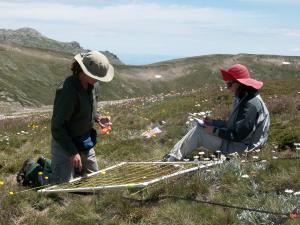
Summer flowering in an alpine herbfield, Kosciuszko National Park. But what is the fate of any viable seed produced?
The climate in Australian alpine areas is changing more rapidly than in lowland areas. Increased temperatures, particularly minima, and significant reductions in snowpack, snow duration and extent are some of the anticipated impacts. The expected climate warming will also present several unprecendented scenarios for plant reproduction; given that temperature is the primary factor for stimulating seed germination and regulating changes in seed dormancy. Successful regeneration via seed will be crucial to species persistence, migration and ongoing recruitment in the future.
But where is the seed? And will it germinate?
After seed matures on the flower; seeds may germinate immediately as suitable conditions arise, disperse to other areas, die, or be incorporated into the soil seed bank. Persistent seedbanks enable species to synchronise their germination with favourable years, while maintaining some seeds in the soil during periods of poor seed production. In contrast, seeds from a transient seedbank remain within the top-soil layers only for a short time and germinate quickly rather than accumulating and working their way deeper into the soil. Which begs the question; how will warmer alpine soils influence current germination rates from the soil seed bank?
Together with my colleagues at the Australian National University and the Australian National Botanic Gardens, we are beginning to understand the role of the alpine soil seed bank under climate change scenarios in Australian alpine areas:
Hoyle GL, Venn SE, Steadman KJ, Good RB, McAuliffe EJ, Williams ER and Nicotra AB. (2013) Soil warming increases plant species richness but decreases germination from the alpine soil seed bank. Global Change Biology in press (doi: 10.1111/gcb.12135)

By understanding the mechanisms driving germination from the alpine soil seed bank with an experimental warming treatment, we can begin to understand the potential effects of climate warming on alpine soils and population recruitment processes.
We ran a simple germination experiment using soil collected from Kosciuszko National Park under two contrasting glasshouse temperature regimes; 1) designed to mimic present day soil temperatures during an optimal growing season; and 2) designed to mimic warmer alpine soil temperatures which reflects a growing season under the climate predictions beyond 2050. Overall, soil temperatures in the warm glasshouse were approximately 4°C warmer than those in the cool glasshouse, both day and night.
We expected warmed soil to increase germination rates and the total number of germinants, which is a common response in laboratory germination trials. Indeed, we recorded 12 more species in the warmed soil treatments; however, we actually saw an overall reduction in germination in the warmed soil treatment. When we examined the data more carefully, germination response to soil temperature was species specific, about 64% of the germinable soil seed bank was made up of Poaceae seeds which did not germinate well in warmed soil; reflecting the dominance of grasses in the system. However, there were some Cyperaceae, Juncaceae and Campanulaceae species which showed higher germination in the warmed soils. Only seeds of local alpine species germinated, and only 2% were identified as weeds.
What does this mean for alpine germination in a warmer world?
There were still 17 species that needed a dose of growth hormone (giberrellic acid, GA3) to overcome physiological dormancy to germinate, indicating that the alpine environment, characterized by cold, snowy winters, may be critical for germination among some species, especially those in the Apiaceae, Rosaceae, Crassulaceae and Boraginaceae. But overall, warmed soil appears to hinder, rather than help alpine seed germination. Should warmer soils in the alpine zone manifest along the lines of our experiment, we might still expect alpine species to maintain populations through transient and/or persistent seeds banks. However, species might begin to rely more heavily on germination immediately post flowering and seed maturation to maintain local species diversity, support species range shifts and maintain species populations under warmer and more variable climates.





